
Main Page
 Main Page |
The Kai Monastery |
As you lose consciousness, the last thing you see in the poor light are the walls of the monastery
crashing to the ground."
So begins the saga of Lone Wolf, last of the Kai Lords. In Flight from the Dark, this first of
Lone Wolf books, the order of the Kai has been nearly wiped out by a sneak attack on the monastery
by the Darklords of Helgedad. The only survivor is Silent Wolf, a young Kai initiate (meaning he
has mastered five of the ten basic Kai disciplines, the secret skills of the Kai). Upon the realization
that he alone represents the future of his order, he takes the name Lone Wolf, and sets out for the
capital city of Holmgard to warn the king that the Kai Lords are dead.
The story is an overland adventure taking place in Sommerlund as the minions of the Darklords
begin to overrun the country. Aside from Lone Wolf, some of the recurring characters from the
series who appear in the book are Banedon, the young theurgist of the Magician's Guild of Toran
(who is destined for greater things) and King Ulnar, King of Sommerlund (and the fifth King Ulnar
in that country's history). Also, depending on what route you take through Holmgard itself, it is
possible to meet a man described as "the captain of the Guard." It is likely this man is Captain
Remir D'Val, one of the greatest of Sommlending warriors, who makes appearances in other Lone
Wolf books, and who more than once saves the life of the last of the Kai Lords.
Also, when Red Fox, a division of Random House, took over publishing the books at number 13,
new cover designs were made in order to preserve a common look to all the books, and I believe the cover
illustrations were all redone as well. Abridged American editions of the books were also made at
some point, though I don't know if they are all still in print. Aside from the tragedy of being
abridged, these books also have black and white maps!
Flight from the Dark is unique among the Lone Wolf adventures. Not only is it the
beginning of the story, it is the shortest book. It has the simplest writing. It has more variety of
paths than any other book. It has more intersecting paths than any other book.
Much of this is probably due to its being the first book. I doubt Joe was so interested in creating the
sort of rich texture you find in the Grandmaster series and more concerned with producing an
adventure which would sell and launch his series. Because of this, Flight From the Dark
does suffer in comparison to later books. It has noticeably less polish, though notably not less
depth.
Without these simple references to a larger world, the book would not hang together so well. It is an
excellent introduction to Sommerlund and its struggle against the Darklords and definitely leaves the
reader wanting to know the outcome of the final battle for Holmgard.
However, the story telling is weak. Passages such as 109 which reads, "The only thing
under the carpet is dirt!" add little to the adventure, aside from a touch of humour. There are many
short passages in Flight From the Dark which could have been made longer. Occasionally a
passage simply asks you to select a random number, an action which could have been incorporated
into the previous passage which sent you there in the first place. Still, due to the interconnectedness
of the paths in Flight From the Dark, some of these short passages cannot be avoided. By
keeping passages simple, Joe was able to weave together different paths through the book,
something that would not have been possible had the passages been longer and therefore more
anchored to a particular path. It is quite an achievement that despite the interconnectedness of the
paths, the book still tells a single story. Although the narrative is choppy, it is not disjointed.
The combination of the simple story, the many options and the occasional details which create a
larger world, make Flight From the Dark one of the more enjoyable Lone Wolf books,
despite its shortcomings. Even though there are so many ways through the book, it still manages to
tell a complete adventure: the dangerous and critically important first journey of the last of the Kai
Lords of Sommerlund.
Vonotar is spelt "Vonatar" in passage 349. I don't know if that's a typo or an earlier
spelling Joe discarded in favour of the later one.
There is also the tremendously strange use of "Sommerlund" in passage 1. Twice,
Sommerlund is used where you would expect Sommlending, as in "the Sommerlund capital" and
"Sommerlund will be at the mercy of their ancient enemy." Again, I don't know if these typos have
been corrected in subsequent printings. I suspect they are leftover from the work of a zealous copy
editor who didn't understand that Sommlending was the adjectival form of Sommerlund, but I'd
love to know for sure.
Mike Richey points out that in passage 58 you can either hide from the
doomwolves or keep running. It seems like an error that hiding gets you killed for sure. On the other
hand, perhaps the change in movement in their peripheral vision makes the Doomwolves notice you
for sure.




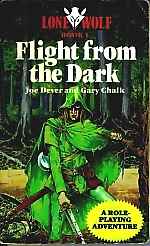 "Suddenly, a great black cloud comes from out of the western skies. So many
are the numbers of black winged beast that fill the sky, that the sun it completely hidden. The
Darklords, ancient enemy of the Sommlending, are attacking. War has begun . . . .
"Suddenly, a great black cloud comes from out of the western skies. So many
are the numbers of black winged beast that fill the sky, that the sun it completely hidden. The
Darklords, ancient enemy of the Sommlending, are attacking. War has begun . . . .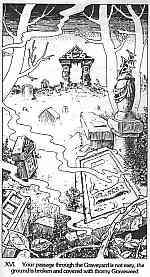 The book was first published in 1984 by Arrow Books, under the name Sparrow Books, presumably
their children's division at the time. It was reprinted twice in 1984 and once in 1986. At some point
during that reprinting, Sparrow Books changed into Beaver Books which continued to publish all
the books up to number 12. The Beaver editions have significantly different cover designs. I know
that the cover illustration itself was also redone at least once by Beaver Books. That new
illustration shows Lone Wolf brandishing his axe, presumably at the battle for Alema bridge.
The book was first published in 1984 by Arrow Books, under the name Sparrow Books, presumably
their children's division at the time. It was reprinted twice in 1984 and once in 1986. At some point
during that reprinting, Sparrow Books changed into Beaver Books which continued to publish all
the books up to number 12. The Beaver editions have significantly different cover designs. I know
that the cover illustration itself was also redone at least once by Beaver Books. That new
illustration shows Lone Wolf brandishing his axe, presumably at the battle for Alema bridge.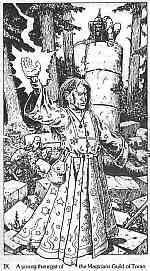 The section where you meet Banedon for the first time betrays a greater story at work behind the
simple journey to Holmgard. The many references to Giaks and how they were used by the
Darklords "to build the infernal city of Helgedad," link the reader to a larger world. The
consistency with which the various creatures are used, and the way they fit in a higherarchy of evil --
from Giaks (always treated as grunts), through the more elite Drakkarim and Gourgaz, to Vordaks
who are obviously in a higher rank as they are regularly seen riding Kraan -- also helps build the
sense of reality which pervades the book.
The section where you meet Banedon for the first time betrays a greater story at work behind the
simple journey to Holmgard. The many references to Giaks and how they were used by the
Darklords "to build the infernal city of Helgedad," link the reader to a larger world. The
consistency with which the various creatures are used, and the way they fit in a higherarchy of evil --
from Giaks (always treated as grunts), through the more elite Drakkarim and Gourgaz, to Vordaks
who are obviously in a higher rank as they are regularly seen riding Kraan -- also helps build the
sense of reality which pervades the book.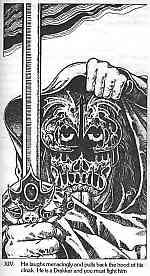 About the only vestiges of an overarching structure in the book occur in the middle and near the end.
The reader must either fight the Gourgaz at the Bridge of Alema, or spend a night on the merchant's
caravan. Also, the reader is always confronted with the choice of three ways of making a final
approach to Holmgard. Aside from these two commonalities, the story is extremely wide open,
allowing for much exploration of the Sommlending countryside.
About the only vestiges of an overarching structure in the book occur in the middle and near the end.
The reader must either fight the Gourgaz at the Bridge of Alema, or spend a night on the merchant's
caravan. Also, the reader is always confronted with the choice of three ways of making a final
approach to Holmgard. Aside from these two commonalities, the story is extremely wide open,
allowing for much exploration of the Sommlending countryside.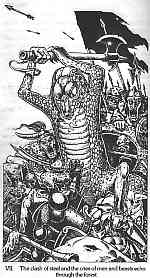 Generally, Flight From the Dark is free of major errors. However, there is a dangerous
mistake in entry 20. That entry tells you to continue at passage 272. The correct
passage to continue at is 273. If you go to 272 you end up back near the
beginning of the book, although interestingly, the text does not seem necessarily out of place (unless
you have already been to 272 in your adventure). I do not know if this error has been
corrected in printings beyond 1986.
Generally, Flight From the Dark is free of major errors. However, there is a dangerous
mistake in entry 20. That entry tells you to continue at passage 272. The correct
passage to continue at is 273. If you go to 272 you end up back near the
beginning of the book, although interestingly, the text does not seem necessarily out of place (unless
you have already been to 272 in your adventure). I do not know if this error has been
corrected in printings beyond 1986.
© Julian Egelstaff 1997-2000
Lone Wolf © TM Joe Dever 1984-2000